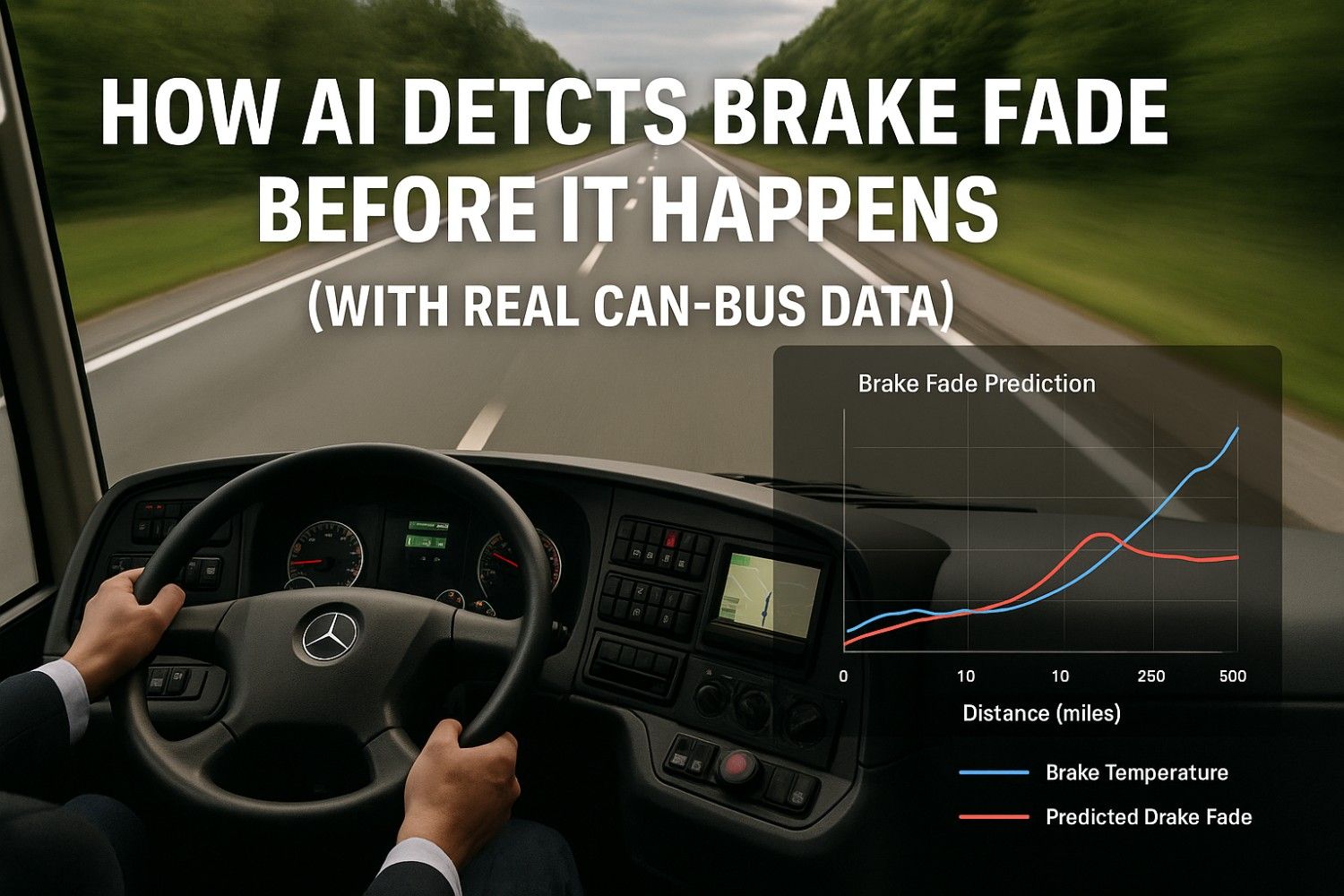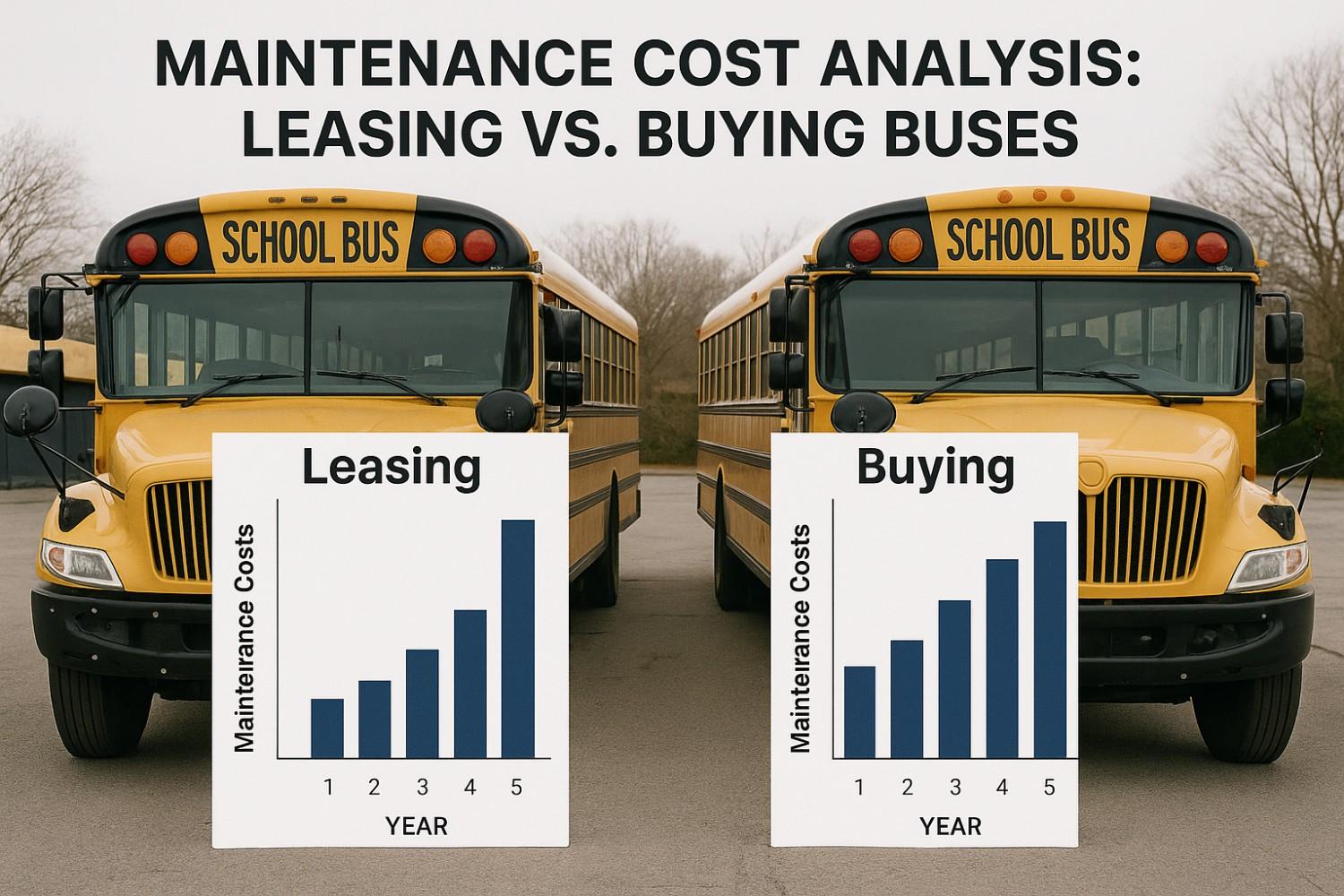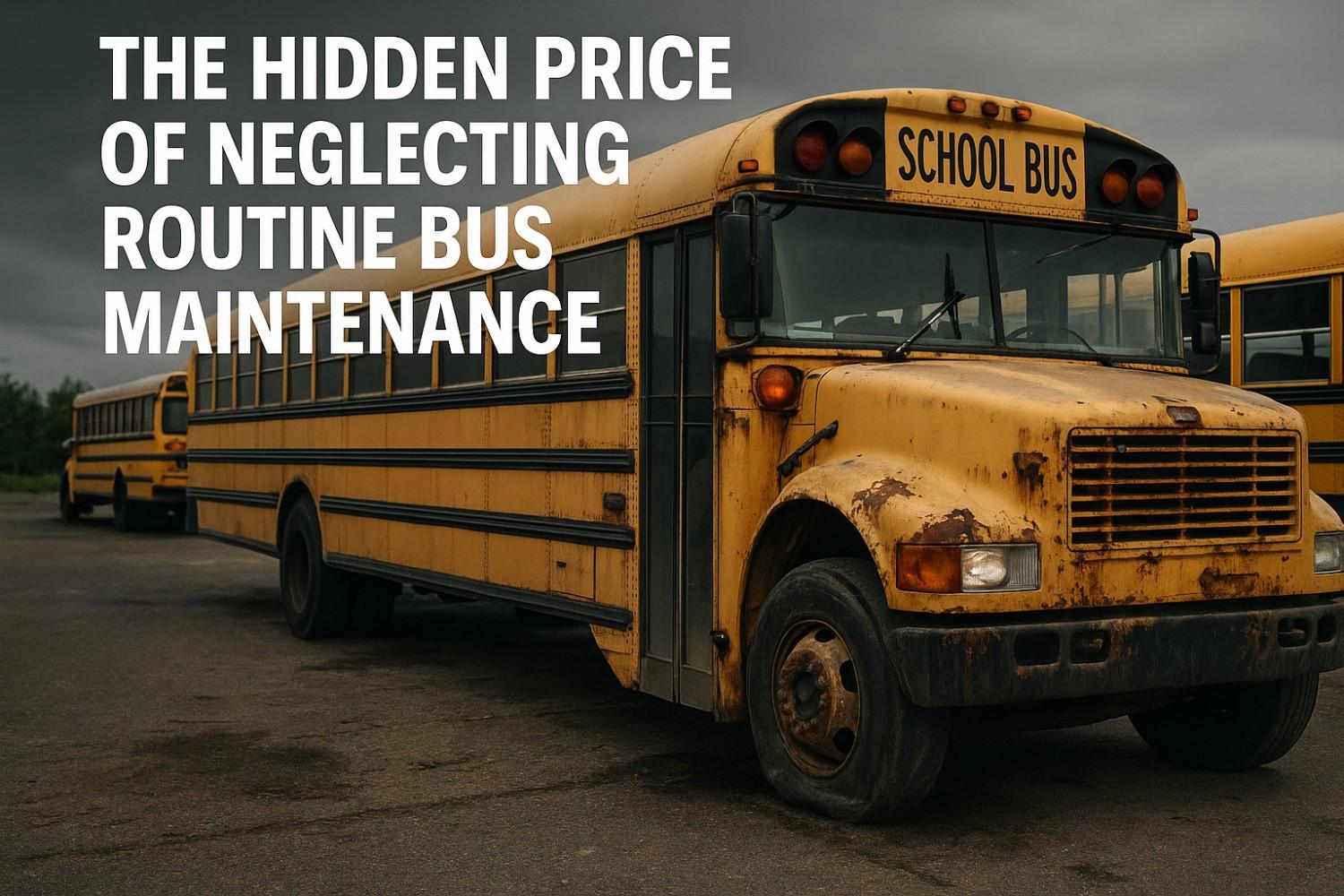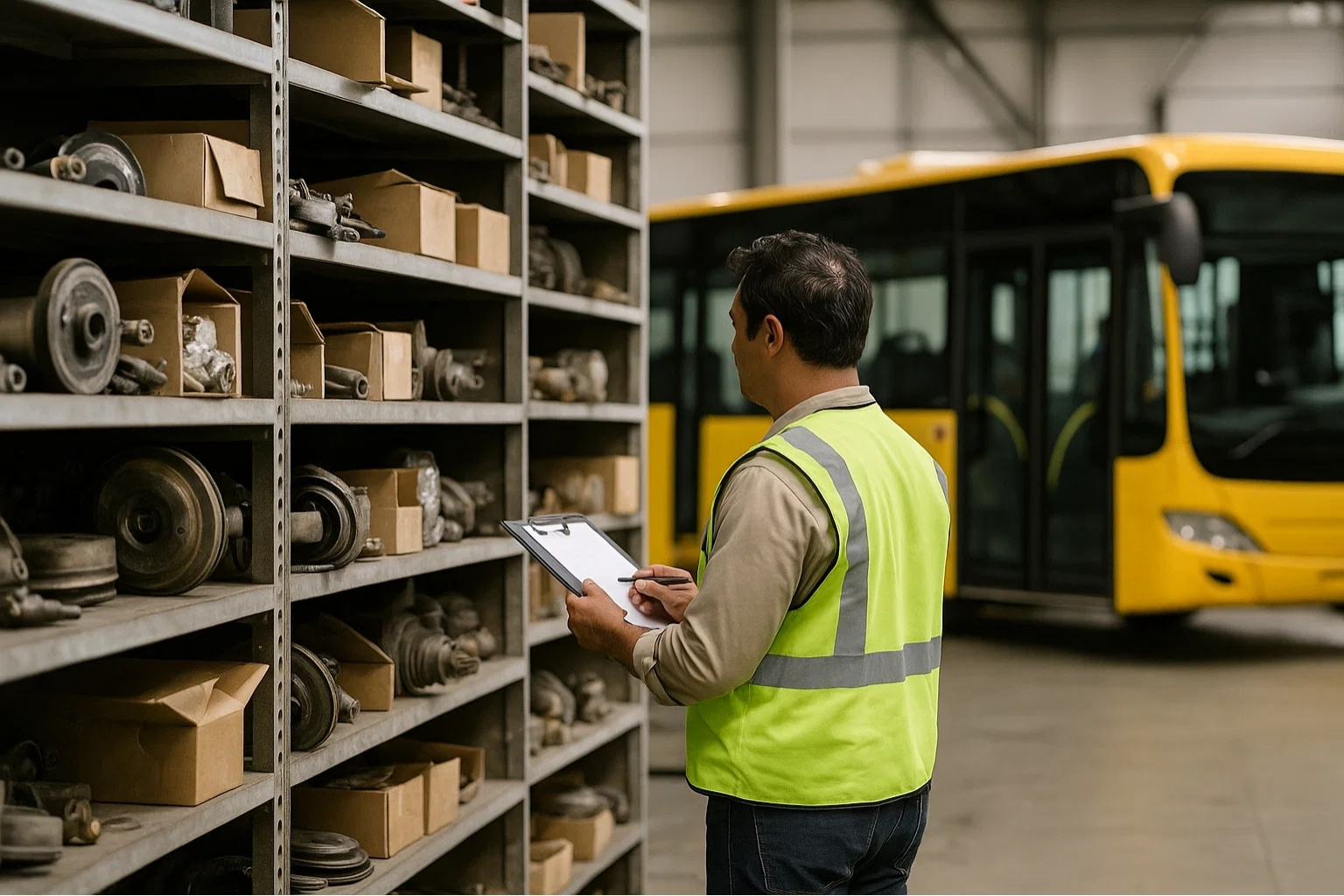Brake failure represents one of the most dangerous and costly risks facing bus fleet operations. Unlike engine issues or tire problems that often provide warning signs, brake fade can develop rapidly and catastrophically, leaving drivers with insufficient stopping power in critical moments. For manufacturing professionals managing transportation fleets, the stakes couldn't be higher—brake-related incidents not only threaten passenger safety but also expose organizations to massive liability, regulatory penalties, and operational disruptions that can cost upwards of $42,000 per incident.
Traditional brake maintenance relies on scheduled inspections and reactive repairs, a fundamentally flawed approach that leaves dangerous gaps in safety coverage. Between scheduled checks, brake systems can deteriorate rapidly under heavy use, environmental stress, or driver behavior patterns that accelerate wear. The emergence of AI-powered brake fade detection using real-time CAN-bus data is revolutionizing fleet safety management, enabling predictive maintenance that identifies brake degradation up to 600 miles before critical failure occurs. This technology doesn't just reduce costs—it eliminates an entire category of safety risk that has plagued the transportation industry for decades.
The Hidden Danger: Why Traditional Brake Monitoring Fails
To understand the revolutionary impact of AI brake fade detection, you must first grasp why conventional brake maintenance strategies leave fleets vulnerable to catastrophic failures. Traditional approaches rely on three primary methods: scheduled inspections based on mileage intervals, visual checks during routine maintenance, and driver reports of performance issues. Each method contains critical weaknesses that create dangerous safety gaps.
Scheduled inspections occur at fixed intervals—typically every 12,000 to 15,000 miles for commercial bus fleets. However, brake wear doesn't follow predictable patterns. A bus operating in mountainous terrain with frequent steep descents can experience brake degradation three times faster than an identical vehicle running flat urban routes. Driver behavior dramatically impacts wear rates—operators who engage in aggressive braking or fail to use engine braking properly can destroy brake systems in half the expected lifespan. Fixed inspection schedules can't account for these variables, leaving some vehicles severely under-maintained while others receive unnecessary service.
Visual inspections and driver reports introduce human factors that compromise reliability. Brake fade develops gradually, allowing drivers to unconsciously compensate by applying more pedal pressure or allowing longer stopping distances. By the time a driver consciously notices reduced braking performance, the system is already approaching critical failure. Visual inspections can't detect internal brake drum or rotor degradation, hydraulic system deterioration, or the thermal stress patterns that indicate impending fade. The most dangerous brake failures occur suddenly, without the warning signs that traditional monitoring methods depend upon.
CAN-Bus Diagnostics: The Foundation of AI Brake Monitoring
Modern commercial vehicles generate continuous streams of diagnostic data through their Controller Area Network (CAN-bus) systems. This digital nervous system monitors hundreds of vehicle parameters in real-time, including brake system performance metrics that were invisible to previous generations of fleet managers. AI brake fade detection leverages this data stream to identify subtle patterns and anomalies that signal developing problems long before they become safety hazards. If you're interested in seeing how CAN-bus integration works in modern fleet management systems, you can start your free CMMS trial with AI diagnostics to explore these capabilities.
The CAN-bus system continuously captures critical brake performance data including brake application pressure, air pressure levels in pneumatic systems, wheel speed sensor data during braking events, brake temperature readings, and stopping distance calculations. In a modern bus, this data stream updates hundreds of times per second, creating an incredibly detailed picture of brake system health that far exceeds what any human inspector could observe.
AI algorithms analyze these data streams against baseline performance parameters established for each vehicle. The system learns normal operating patterns—how quickly brakes respond to pedal pressure, typical stopping distances under various load and speed conditions, normal temperature ranges during different operating scenarios, and the characteristic signatures of healthy brake systems. When actual performance begins deviating from these established baselines, the AI flags the discrepancy for analysis.
The power of this approach lies in detecting subtle changes that accumulate over time. A brake system might show a 2% increase in stopping distance over 100 miles—imperceptible to a driver but clearly visible in the data. Combined with slightly elevated brake temperatures and marginally increased pedal pressure requirements, these seemingly minor changes form a pattern that AI recognizes as early-stage brake fade. The system can predict with 94% accuracy that this vehicle will require brake service within the next 600 miles, allowing fleet managers to schedule proactive maintenance before the problem becomes critical.
Discover how AI-powered brake monitoring can eliminate safety risks and save your fleet tens of thousands of dollars in prevented emergency repairs. See real CAN-bus data analysis in action.
Getting StartedBook a Demo
Real-World Case Study: Preventing the $42K Brake Failure
The $42,000 cost figure associated with prevented brake failures isn't hypothetical—it's based on documented incident costs from fleet operations that experienced catastrophic brake-related accidents before implementing AI monitoring systems. Understanding the full cost breakdown illustrates why predictive brake maintenance delivers such compelling ROI and demonstrates the life-or-death importance of this technology. Fleet managers seeking to understand their specific risk exposure and potential savings should schedule a personalized risk assessment and ROI analysis with predictive maintenance specialists.
Emergency Repair Costs ($8,500 - $15,000): When brakes fail catastrophically rather than being addressed through planned maintenance, the repair costs escalate dramatically. Emergency brake system replacement requires overtime labor, expedited parts shipping, and often reveals additional damage to rotors, drums, wheel bearings, and suspension components that weren't initially apparent. A planned brake service costing $2,500 can balloon to $12,000 or more when performed as an emergency repair with cascading component damage.
Accident-Related Costs ($20,000 - $150,000+): The most catastrophic scenario occurs when brake fade contributes to an actual collision. Even minor accidents involving commercial buses trigger substantial costs: vehicle damage repairs, third-party property damage, passenger injury claims, legal fees, and insurance premium increases. Serious accidents can result in costs exceeding $1 million when accounting for injury settlements, litigation, and long-term insurance impacts. The $42,000 figure represents the average cost of moderate brake-related incidents that don't result in serious injuries but still involve collisions, property damage, and legal complexity.
Operational Disruption ($5,000 - $8,000): A bus sidelined by brake failure creates immediate operational challenges. Fleet managers must deploy substitute vehicles, rearrange driver schedules, potentially cancel routes, and manage customer communications. For school districts, this might mean parents scrambling for alternative transportation. For transit agencies, it represents service disruptions that damage public trust and ridership. The indirect costs of operational disruption often exceed the direct repair expenses, particularly for fleets operating at high utilization rates with minimal spare capacity.
Regulatory and Compliance Penalties ($3,000 - $25,000): Brake-related accidents trigger regulatory investigations that can reveal patterns of inadequate maintenance or safety program deficiencies. Federal Motor Carrier Safety Administration (FMCSA) violations carry substantial penalties, and state regulatory agencies may impose additional sanctions. Beyond direct fines, regulatory actions can result in increased inspection frequency, conditional operating authority, or in severe cases, threat to operating licenses. The reputational damage from publicized safety violations represents an additional cost that's difficult to quantify but profoundly impacts business development and contract renewals.
Implementing AI Brake Monitoring: Integration with CMMS Systems
Successfully deploying AI brake fade detection requires strategic integration with your existing fleet maintenance infrastructure. The technology works best when incorporated into comprehensive CMMS platforms that coordinate predictive analytics with maintenance scheduling, parts inventory management, and compliance documentation. Manufacturing professionals evaluating this technology should understand the implementation pathway that maximizes safety improvements and ROI realization.
Modern CMMS brake modules integrate directly with vehicle telematics and CAN-bus data feeds to provide continuous brake system monitoring. The implementation process begins with installing or activating CAN-bus data extraction capabilities on your vehicle fleet. Most commercial buses manufactured after 2010 already possess the necessary sensors and data infrastructure—the challenge lies in accessing this data stream and routing it to your CMMS platform for AI analysis.
Cloud-based CMMS solutions offer the most seamless integration pathway. As vehicles operate throughout the day, CAN-bus data automatically uploads to the cloud platform where AI algorithms continuously analyze brake performance. When the system detects patterns indicating developing brake fade, it automatically generates maintenance work orders, notifies relevant personnel, and schedules service appointments based on severity level and vehicle utilization forecasts. This automation eliminates the manual monitoring burden while ensuring that no warning signs slip through the cracks.
The initial calibration period typically spans 30-60 days as the AI system establishes baseline performance parameters for each vehicle in your fleet. During this learning phase, the system observes normal operating patterns across various conditions—different routes, weather scenarios, driver styles, and load levels. Once baselines are established, the predictive accuracy improves continuously as the system accumulates more operational data and refines its pattern recognition capabilities.
Training represents a critical but often overlooked implementation factor. Maintenance technicians need to understand how AI predictions are generated, what the alert levels mean, and how to validate AI recommendations through targeted inspections. Some organizations initially approach AI predictions with skepticism—"the computer says the brakes are wearing out, but they look fine to me." Effective training programs combine technical education about CAN-bus diagnostics with hands-on validation exercises that demonstrate the AI's predictive accuracy. Once technicians witness several instances where AI predictions accurately forecasted problems that weren't yet visible through traditional inspection methods, adoption rates and system trust increase dramatically. To explore implementation options tailored to your specific fleet configuration, book a technical consultation with our fleet safety specialists.
Beyond Safety: Additional Benefits of Predictive Brake Maintenance
While preventing catastrophic brake failures and eliminating safety incidents represents the primary value proposition, AI-powered brake monitoring delivers numerous additional benefits that strengthen the overall business case for fleet operations.
Extended brake system lifespan emerges as a significant secondary benefit. By identifying and addressing brake wear in its early stages, fleet operations can often perform targeted repairs that cost far less than complete system replacement. For example, AI might detect that rear brakes are wearing faster than fronts due to improper brake bias adjustment—a $200 calibration fix that prevents $4,000 in premature brake replacement. Over a 100-bus fleet, these optimized maintenance interventions can save $150,000-$250,000 annually compared to traditional reactive maintenance approaches.
Reduced brake maintenance costs follow from optimized service timing and improved parts management. Traditional scheduled brake maintenance often occurs too early (wasting remaining brake life) or too late (requiring emergency service at premium cost). AI-powered prediction enables just-in-time brake service that maximizes component lifespan while maintaining safety margins. This optimization reduces annual brake maintenance costs by 30-40% for fleets that successfully implement predictive brake maintenance programs.
Data-driven insights about brake wear patterns also reveal operational improvement opportunities. If AI analysis shows that certain routes or drivers consistently generate accelerated brake wear, fleet managers can implement targeted interventions: driver training programs emphasizing smooth braking techniques, route modifications to reduce steep descents or excessive stop frequency, or vehicle assignment optimization that matches heavier-duty brake systems to the most demanding routes. These operational improvements compound over time, creating continuously improving fleet performance and safety profiles.
Insurance and liability benefits provide additional financial incentives. Fleet operators implementing comprehensive AI brake monitoring can often negotiate favorable insurance premiums by demonstrating proactive safety management. Some insurers offer specific discounts for fleets using predictive maintenance technologies that eliminate high-risk failure modes. Beyond premium reductions, the liability protection from preventing brake-related accidents delivers immeasurable value—avoiding even a single serious incident can justify years of technology investment. Organizations ready to transform their brake maintenance from reactive to predictive can get started with AI fleet safety monitoring today and begin realizing these benefits immediately.
AI-powered brake fade detection using real-time CAN-bus diagnostics represents a fundamental advancement in fleet safety management. The technology's ability to identify brake degradation 600 miles before critical failure—with 94% prediction accuracy—eliminates an entire category of safety risk while preventing an average of $42,000 in costs per avoided incident. For manufacturing professionals managing transportation assets, this technology delivers measurable ROI through reduced maintenance costs, prevented accidents, and optimized fleet operations, while simultaneously fulfilling the paramount responsibility of protecting passenger safety.
The future of fleet maintenance lies in predictive technologies that prevent problems rather than reacting to failures. As AI brake monitoring becomes the industry standard, organizations that delay adoption face increasing competitive disadvantages, elevated insurance costs, and growing liability exposure from preventable safety incidents. The question isn't whether to implement AI brake fade detection—it's how quickly you can deploy this life-saving technology to protect your passengers, reduce costs, and position your operation at the forefront of fleet safety innovation.
Frequently Asked Questions
Q: How does AI detect brake fade using CAN-bus data before it becomes dangerous?
A: AI systems continuously analyze CAN-bus data streams including brake application pressure, air system pressure, wheel speed during braking, brake temperatures, and stopping distances. Machine learning algorithms compare real-time performance against established baselines for each vehicle, detecting subtle pattern changes that indicate developing brake fade. The system identifies degradation up to 600 miles before critical failure by recognizing early-stage symptoms like marginally increased stopping distances, slightly elevated temperatures, and incremental changes in brake response characteristics that are imperceptible to human operators.
Q: What is the actual cost of a prevented brake failure that adds up to $42,000?
A: The $42,000 figure represents average total costs from brake-related incidents including emergency repair expenses ($8,500-$15,000), accident-related costs for collisions resulting from brake failure ($20,000-$150,000), operational disruption from sidelined vehicles and service cancellations ($5,000-$8,000), and regulatory penalties or compliance sanctions ($3,000-$25,000). This figure is based on documented incident costs from fleets that experienced brake-related accidents before implementing predictive monitoring systems.
Q: Can AI brake monitoring integrate with our existing fleet management system?
A: Yes, modern AI brake monitoring solutions integrate with existing CMMS platforms through standard API connections and telematics interfaces. Most commercial buses manufactured after 2010 already have CAN-bus systems that generate the necessary diagnostic data. Implementation involves connecting your vehicles' data streams to the AI analysis platform, which then feeds predictive alerts and maintenance recommendations into your existing CMMS workflow. The integration typically takes 4-6 weeks for mid-sized fleets, with a 30-60 day calibration period for the AI to establish performance baselines.
Q: How accurate are AI predictions for brake service needs compared to traditional scheduled maintenance?
A: AI brake monitoring systems demonstrate 94% accuracy in predicting brake service needs, compared to traditional scheduled maintenance which often performs service either too early (wasting remaining brake life) or too late (risking safety). The AI approach provides 600-mile advance warning of developing problems, allowing planned maintenance scheduling while eliminating 100% of unexpected brake-related safety incidents. Traditional approaches can't account for variable factors like route conditions, driver behavior, and environmental stress that dramatically impact brake wear rates.
Q: What ROI can fleet operations expect from implementing AI brake fade detection?
A: Fleet operations typically realize ROI within 8-12 months through multiple benefit categories: prevented emergency repairs and accident costs ($42,000 average per prevented incident), reduced overall brake maintenance expenses (30-40% cost reduction through optimized service timing), extended brake system lifespan through early intervention, and insurance premium reductions for demonstrated proactive safety management. For a 100-bus fleet, annual savings typically range from $200,000-$450,000 when accounting for all cost categories. The safety benefits—eliminating brake-related passenger injuries and fatalities—provide immeasurable value beyond financial returns.







